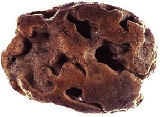
Halichondria
Encyclopedia
Halichondria is a genus of marine demosponge
s belonging to the family Halichondriidae
. These are massive, amorphous sponges with clearly separated inner and outer skeletons consisting of bundles of spicules arranged in a seemingly random pattern. This genus of sponges became important through the discovery of cell division
limiting properties of the extract Halichondrin B
, which inhibits cell mitosis
. The drug Eribulin
, a related compound and an inhibitor of microtubule
function, has become an important chemotherapy
treatment for certain types of cancer.
Demosponge
The Demospongiae are the largest class in the phylum Porifera. Their "skeletons" are made of spicules consisting of fibers of the protein spongin, the mineral silica, or both. Where spicules of silica are present, they have a different shape from those in the otherwise similar glass sponges...
s belonging to the family Halichondriidae
Halichondriidae
Halichondriidae is a family of marine demosponges belonging to the order Halichondrida. These sponges have a skeleton consisting of dense bundles of spicules occurring in a more or less random pattern.-References:**...
. These are massive, amorphous sponges with clearly separated inner and outer skeletons consisting of bundles of spicules arranged in a seemingly random pattern. This genus of sponges became important through the discovery of cell division
Cell division
Cell division is the process by which a parent cell divides into two or more daughter cells . Cell division is usually a small segment of a larger cell cycle. This type of cell division in eukaryotes is known as mitosis, and leaves the daughter cell capable of dividing again. The corresponding sort...
limiting properties of the extract Halichondrin B
Halichondrin B
Halichondrin B is a naturally occurring compound originally isolated from the marine sponge Halichondria okadai by Hirata and Uemura in 1986. In the same report, these authors also reported the exquisite anticancer activity of halichondrin B against murine cancer cells both in culture and in in...
, which inhibits cell mitosis
Mitosis
Mitosis is the process by which a eukaryotic cell separates the chromosomes in its cell nucleus into two identical sets, in two separate nuclei. It is generally followed immediately by cytokinesis, which divides the nuclei, cytoplasm, organelles and cell membrane into two cells containing roughly...
. The drug Eribulin
Eribulin
Eribulin is an anticancer drug marketed by Eisai Co. under the trade name Halaven. Eribulin mesylate was approved by the U.S. Food and Drug Administration on November 15, 2010, to treat patients with metastatic breast cancer who have received at least two prior chemotherapy regimens for late-stage...
, a related compound and an inhibitor of microtubule
Microtubule
Microtubules are a component of the cytoskeleton. These rope-like polymers of tubulin can grow as long as 25 micrometers and are highly dynamic. The outer diameter of microtubule is about 25 nm. Microtubules are important for maintaining cell structure, providing platforms for intracellular...
function, has become an important chemotherapy
Chemotherapy
Chemotherapy is the treatment of cancer with an antineoplastic drug or with a combination of such drugs into a standardized treatment regimen....
treatment for certain types of cancer.
Species
- Halichondria adelpha
- Halichondria agglomerans
- Halichondria aldabrensis
- Halichondria arenacea
- Halichondria arenosa
- Halichondria armata
- Halichondria aspera
- Halichondria attenuata
- Halichondria axinelloides
- Halichondria bergquistae
- Halichondria bowerbankiHalichondria bowerbankiHalichondria bowerbanki is a species of sponge that lives on rocky surfaces in the shallow subtidal, with occasional intertidal specimens under overhanging rocks. The physical appearance and structure of the species is variable and it has tassel-like irregular branches. Colonies can be up to 25...
- Halichondria brunnea
- Halichondria cebimarensis
- Halichondria coerulea
- Halichondria colossea
- Halichondria contorta
- Halichondria convolvens
- Halichondria cornuloides
- Halichondria corrugata
- Halichondria cristata
- Halichondria cylindrata
- Halichondria darwinensis
- Halichondria diversispiculata
- Halichondria dubia
- Halichondria fragilis
- Halichondria glabrata
- Halichondria granulata
- Halichondria heterorhaphis
- Halichondria incrustans
- Halichondria intermedia
- Halichondria knowltoni
- Halichondria labiata
- Halichondria lambei
- Halichondria lendenfeldi
- Halichondria leuconoides
- Halichondria longispicula
- Halichondria lutea
- Halichondria magniconulosa
- Halichondria melanodocia
- Halichondria miggottea
- Halichondria minuta
- Halichondria moorei
- Halichondria normani
- Halichondria oblonga
- Halichondria okadai
- Halichondria osculum
- Halichondria oshoro
- Halichondria paniceaHalichondria paniceaHalichondria panicea, commonly known as the breadcrumb sponge, is a species of marine demosponge belonging to the family Halichondriidae. This is an abundant sponge of coastal areas of the North Atlantic and the Mediterranean Sea ranging from the intertidal zone to a recorded depth of over 550 m...
- Halichondria pelliculata
- Halichondria phakellioides
- Halichondria prostrata
- Halichondria renieroides
- Halichondria ridleyi
- Halichondria semitubulosa
- Halichondria sitiens
- Halichondria stylata
- Halichondria sulfurea
- Halichondria surrubicunda
- Halichondria syringea
- Halichondria tenebrica
- Halichondria tenera
- Halichondria tenuiderma
- Halichondria tenuiramosa
- Halichondria tenuispiculata
- Halichondria vansoesti
- Halichondria velamentosa

